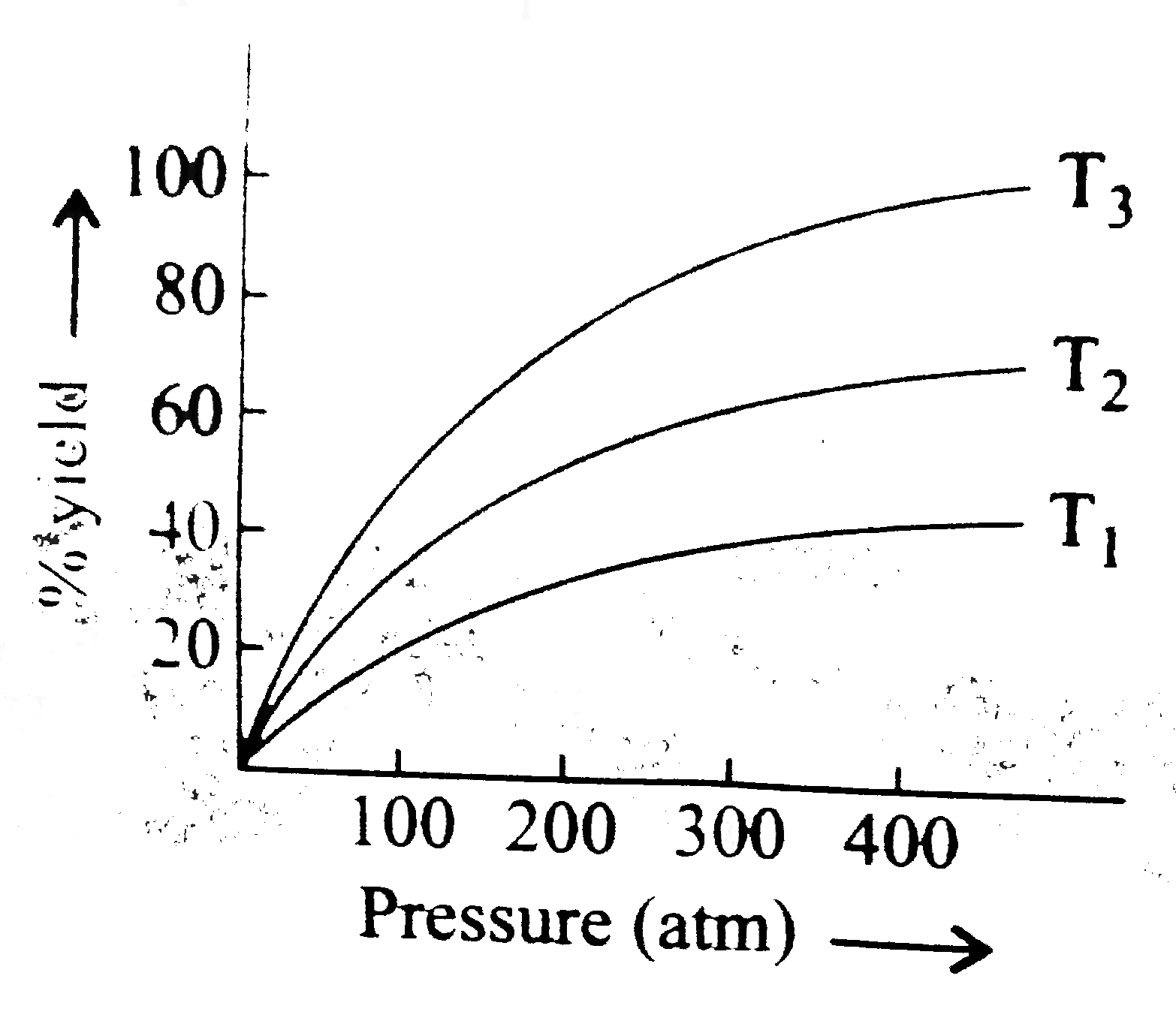At constant pressure, the addition of argon in Haber's process
Reduces the formation of ammonia from N2andH2
Increases the formation of ammonia from N2andH2
Does not affect the equlibrium of the reaction in which ammonia is formed from N2andH2
Reduces the dissociation of ammonia
The correct Answer is:A
To solve the question regarding the effect of adding argon gas at constant pressure in the Haber process, we can follow these steps:
Step 1: Understand the Haber Process
The Haber process is a chemical reaction used to synthesize ammonia (NH3) from nitrogen (N2) and hydrogen (H2). The balanced equation for this reaction is:
N2(g)+3H2(g)⇌2NH3(g)
Step 2: Identify the Moles of Gases
In the balanced equation, we have:
- Reactants: 1 mole of N2 + 3 moles of H2 = 4 moles of gas
- Products: 2 moles of NH3
Step 3: Consider the Effect of Adding Argon
Argon is an inert gas, meaning it does not react with the other gases in the reaction. When argon is added at constant pressure, it increases the total number of gas molecules in the system. However, since the pressure is held constant, the volume of the system must change.
Step 4: Apply Le Chatelier's Principle
According to Le Chatelier's principle, if a system at equilibrium is subjected to a change in conditions (such as pressure or volume), the equilibrium will shift in a direction that counteracts that change.
In this case, since we are effectively decreasing the volume (to maintain constant pressure with the addition of argon), the equilibrium will shift toward the side with fewer moles of gas to minimize the change.
Step 5: Determine the Direction of the Shift
In our reaction:
- The reactants side has 4 moles of gas.
- The products side has 2 moles of gas.
Since the addition of argon (an inert gas) leads to a decrease in volume, the equilibrium will shift to the left (toward the reactants) to reduce the number of gas moles.
Step 6: Conclusion
As a result, the addition of argon gas reduces the formation of ammonia from nitrogen and hydrogen. Therefore, the correct option is:
Option 1: Reduces the formation of ammonia from N2 and H2.
---
The Haber process is a chemical reaction used to synthesize ammonia (NH3) from nitrogen (N2) and hydrogen (H2). The balanced equation for this reaction is:
In the balanced equation, we have:
- Reactants: 1 mole of N2 + 3 moles of H2 = 4 moles of gas
- Products: 2 moles of NH3
Argon is an inert gas, meaning it does not react with the other gases in the reaction. When argon is added at constant pressure, it increases the total number of gas molecules in the system. However, since the pressure is held constant, the volume of the system must change.
According to Le Chatelier's principle, if a system at equilibrium is subjected to a change in conditions (such as pressure or volume), the equilibrium will shift in a direction that counteracts that change.
In our reaction:
- The reactants side has 4 moles of gas.
- The products side has 2 moles of gas.
As a result, the addition of argon gas reduces the formation of ammonia from nitrogen and hydrogen. Therefore, the correct option is:
Topper's Solved these Questions
- EQUILIBRIUMBook:AAKASH INSTITUTE ENGLISHChapter:EQUILIBRIUMExercise:Assignment (SECTION-C) (OBJECTIVE TYPE QUESTIONS (MORE THAN ONE OPTION ARE CORRECT)
Explore 10 Videos
- EQUILIBRIUMBook:AAKASH INSTITUTE ENGLISHChapter:EQUILIBRIUMExercise:Assignment (SECTION-D) (LINKED COMPREHENSION TYPE QUESTIONS)
Explore 8 Videos
- EQUILIBRIUMBook:AAKASH INSTITUTE ENGLISHChapter:EQUILIBRIUMExercise:Assignment (SECTION-A) (SUBJECTIVE TYPE QUESTIONS(ONE OPTION IS CORRECT)
Explore 45 Videos
- ENVIRONMENTAL CHEMISTRYBook:AAKASH INSTITUTE ENGLISHChapter:ENVIRONMENTAL CHEMISTRYExercise:ASSIGNMENT (SECTION-D) (Assertion - Reason Type Questions)
Explore 4 Videos
- GENERAL PRINCIPLES AND PROCESSES OF ISOLATION OF ELEMENTSBook:AAKASH INSTITUTE ENGLISHChapter:GENERAL PRINCIPLES AND PROCESSES OF ISOLATION OF ELEMENTSExercise:Assignment (Section-D) Assertion-Reason Type Question
Explore 15 Videos
Similar Questions
At constant pressure , addition of helium to the reaction system : N2(g)+3H3(g)⇔2NH3(g)
View SolutionFor the reaction A_((s)) + 2B_((g)) hArr 3C_((g)) . At constant pressure on addition of inert gas, the equilibrium state
View SolutionGive reasons for the following .
Finely divided iron catalyst does not affect the percentage yield of ammonia in Haber 's process.
View SolutionGive balanced equation for Habers process.
View SolutionN2(g)+3H2(g)⇔2NH3(g),ΔHɵ=−22.4kJ
The pressure inside the chamber is 100 atm and temperature at 300K
The preparation of ammonia by Haber's process is an exothermic reaction. If the preparation follows the following temperature-pressure relationship for its % yield. Then for temperature T1,T2 and T3 the correct option is:

View SolutionUnder what conditions do nitrogen and hydrogen combine to form ammonia in Haber's process?
View SolutionIn the industrial preparation of ammonia by Haber process from nitrogen and hydrogen, the reaction is carried in the temperature range of 450∘C to 500∘C and in a pressure range of 200 atm to 300 atm. Now answer the following question.
The reaction is not carried at very high pressure. Give one reason.
View SolutionExplain why high pressure is used in the manufacture of ammonia by Haber's process. State the law or principle used.∗∗
View SolutionDescribe the favourable conditions for the manufacture of (i) ammonia by Haber's process, and (ii) sulphuric acid by contact process.
View SolutionThe catalyst used in the manufacture of ammonia by Haber process is
View Solution